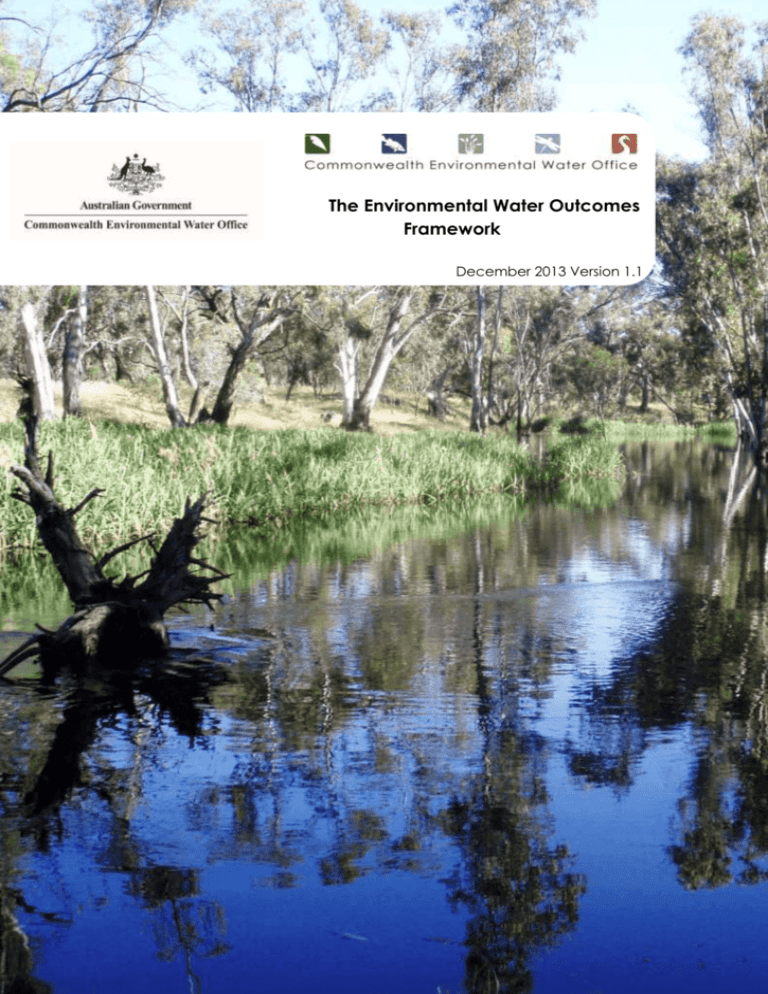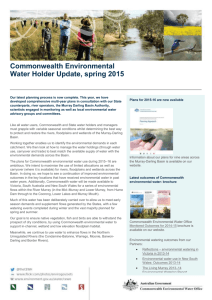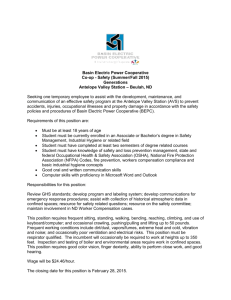Environmental Water Outcomes Framework
advertisement

The Environmental Water Outcomes Framework December 2013 Version 1.1 John Gorton Building King Edward Terrace Parkes ACT 2600 GPO Box 787 Canberra ACT 2601 | 02 6275 9245 | www.environment.gov.au/ewater Image Credits Edward-Wakool River System © SEWPAC, Photographer: Rebecca Gee This report should be cited as ‘Commonwealth Environmental Water – The Environmental Water Outcomes Framework, Commonwealth Environmental Water Office, December 2013 V1.0’. Published by the Commonwealth Environmental Water Holder for the Australian Government. © Commonwealth of Australia 2013. This work is copyright. Apart from any use as permitted under the Copyright Act 1968, no part may be reproduced by any process without prior written permission from the Commonwealth. Requests and enquiries concerning reproduction and rights should be addressed to Department of the Environment, Public Affairs, GPO Box 787 Canberra ACT 2601or email public.affairs@environment.gov.au Information presented in this document may be copied for personal use or published for education purposes, provided that any extracts are fully acknowledged. The views and opinions expressed in this publication are those of the authors and do not necessarily reflect those of the Australian Government or the Minister for the Environment. While reasonable efforts have been made to ensure that the contents of this publication are factually correct, the Commonwealth does not accept responsibility for the accuracy or completeness of the contents, and shall not be liable for any loss or damage that may be occasioned directly or indirectly through the use of, or reliance on, the contents of this publication. Introduction This outcomes framework sets out the best available science for how environmental water provides benefits for the environment. It underpins the management of Commonwealth environmental water and is used to: guide environmental watering understand and demonstrate environmental outcomes ensure environment watering aligns with the objectives of the Environmental Watering Plan (Chapter 8 of the Basin Plan). The framework was developed by the Murray-Darling Freshwater Research Centre (MDFRC) and represents the cumulative knowledge of decades of scientific research and water management practice. It is based on a literature review, presented in the form of cause and effect diagrams. The outcomes framework provides a common language for describing the objectives and environmental outcomes from Commonwealth environmental watering. It applies to all aspects of environmental water management from planning and delivery through to outcomes and communication. The outcomes framework has been framed in a general way to ensure that it can be applied broadly across the Basin, and is articulated as a hierarchy that helps manage environmental water. Importantly, it helps demonstrate how individual watering actions at an area scale contribute to the long-term objectives for the Basin. Basin Plan – Objectives relevant to Commonwealth environmental water The Environmental Watering Plan contains three environmental objectives for water-dependent ecosystems as outlined in Table 1 below, which contribute to clean water and a sustainable Basin. In addition, the Water Quality and Salinity Management Plan objective supports the environmental watering plan. These objectives are long term, with a timeframe of greater than 10 years, and operate at the Basin scale. Commonwealth environmental water is just one lever that helps achieve these objectives, with state water resource plans and environmental watering, and other programs also contributing. Table 1. Objectives relevant to Commonwealth environmental water management Basin Plan Reference Basin Plan Objective Short label “to protect and restore water-dependent ecosystems of the Murray-Darling Basin” Biodiversity (Basin Plan, Chapter 8, Part 2, 8.04(a)) Environmental watering plan “to protect and restore the ecosystem functions of water-dependent ecosystems” Ecosystem function (Basin Plan, Chapter 8, Part 2, 8.04(b)) “to ensure that water-dependent ecosystems are resilient to climate change and other risks and threats” Resilience (Basin Plan, Chapter 8, Part 2, 8.04(c)) Water quality and “to ensure water quality is sufficient to achieve the salinity above objectives for water-dependent management plan ecosystems, and, for Ramsar wetlands, sufficient to maintain ecological character” Water quality (Basin Plan, Chapter 9, Part 3, 9.04 (1) & (2)) Expected outcomes The environmental water outcomes framework is hierarchy of expected outcomes based around the Basin environmental watering objectives. Expected outcomes are matters that best available science indicates can be achieved from environmental watering: within a one year timeframe (1 year expected outcomes) within a one year to five year timeframe (5 year expected outcomes). Each expected outcome is supported by one or more cause and effect diagrams, which are described further in Attachment A. Basin outcomes that relate to environmental watering and other levers under Basin Plan sit below the broad objectives. Spatial scales are important in considering the outcomes from environmental watering. The outcomes framework provides a basis for demonstrating how environmental water over successive years accumulates over time to provide outcomes at the Basin-scale. An example for fish is provided at Attachment A. Table 2. Environmental outcomes framework (showing related Cause and Effect Diagrams) Basin Plan Objectives Basin Outcomes 5 year Expected Outcomes • Species diversity Within Ecosystem Diversity • Vegetation diversity Landscape Vegetation Diversity Vegetation • Growth and survival Macroinvertebrates Species diversity Waterbirds Other vertebrate diversity • Germination • Dispersal Vegetation Recruitment and Extent • Fish diversity Landscape Fish Diversity • Condition Fish Condition • Larval abundance • Reproduction Fish Reproduction • Larval and juvenile recruitment Fish Larval Growth and Survival • Waterbird diversity Landscape Waterbird Diversity • Waterbird diversity and population condition (Abundance and Population structure) • Survival and condition Waterbird Survival and Condition • Chicks Waterbird Reproduction • Fledglings Waterbird Recruitment and Fledging • Young Other Vertebrate Reproduction Other Vertebrate Growth and Survival • Adult abundance Connectivity (Basin Plan S. 8.06) Process • Population condition (individual refuges) (Basin Plan S. 8.07) Vegetation Condition and Reproduction Within Ecosystem Macroinvertebrate Diversity Ecosystem Function Ecosystem resilience • Reproduction • Condition • Macroinvertebrate diversity Fish (Basin Plan S. 8.05) Resilience • Hydrological connectivity including end of system flows Hydrological Connectivity (including end of system flows) • Biotic dispersal and movement Biotic Dispersal • Sediment transport Sediment Transport • Primary productivity (of aquatic ecosystems) Primary Production • Decomposition Decomposition • Nutrient and carbon cycling Nutrient and Carbon Cycling • Individual survival and condition (Individual refuges) Individual Refuges • Population condition (landscape refuges) Landscape Refuges • Individual condition (Ecosystem resistance) • Population condition (Ecosystem recovery) Water quality Chemical (Basin Plan S. 9.04) Biological Related Cause and Effect Diagram (Reference only) Landscape Ecosystem Diversity Ecosystem diversity Biodiversity 1 year Expected Outcomes Ecosystem Resistance Ecosystem Recovery • Salinity Salinity • Dissolved oxygen Dissolved Oxygen • pH pH • Dissolved organic carbon Dissolved Organic Carbon • Algal blooms Algal Blooms How the Office uses the outcomes framework The outcomes framework will support the Office’s: approach to environmental watering monitoring and evaluation of outcomes from environmental watering reporting obligations. Environmental watering The Office uses the outcomes framework in articulating the purpose of water use options. It also supports a clear demonstration of how water use decisions are both consistent with and will contribute to the Environmental Watering Plan objectives. Importantly, the timeframes used to define expected outcomes (1, 5 and 10 years) align with the planning hierarchy for Commonwealth environmental water: annual water use options 5 year portfolio management strategies the 10 year Basin Plan. Monitoring and evaluation The outcomes framework provides the focus for monitoring and helps bring together results from across the Basin in a consistent way for managing information. It provides a basis for evaluating monitoring results at a Basin scale and a sound scientific rationale to extrapolate1 outcomes of environmental watering in areas that the Office cannot monitor. The outcomes framework will also support situations where we must infer2 environmental outcomes, which will contribute to the Basin scale evaluation of Commonwealth environmental water. Reporting and communication The outcomes framework provides a common language that can be used in managing environmental water and communicating outcomes. It is being built into water delivery databases to enable reporting against the agreed outcomes. The framework allows the Office to report on outcomes and the contribution to the Environmental Watering Plan objectives. Extrapolate outcomes – translate outcomes from an area monitored to an area that has not been monitored. Infer outcomes – translate monitored outcomes at a particular site up or down the scales represented in the outcomes hierarchy for an outcome (e.g. from <1 year expected outcomes to whole of Basin outcomes). 1 2 Attachment A Outcomes framework diagrams Two types of diagrams are used to show the relationships between spatial and temporal scale of expected outcomes and the causes of these outcomes: spatio-temporal diagrams (for whole of Basin outcomes) – illustrate the links, across a range of temporal and spatial scales, between expected outcomes that contribute to the particular whole of Basin outcome cause and effect diagrams – explain the influence of flow and other factors on elements of the outcomes framework. Spatio-temporal diagrams Figure 1 shows the spatio-temporal diagram for the fish whole of Basin outcome. A description of the various elements of this diagram is provided below. Figure 1. Spatio-temporal representation of outcomes for fish Expected outcomes for fish in less than one year Murray cod and golden perch are found at a site with suitable habitat. Australian smelt and gudgeons are found at another site within the catchment. These fish need to be in a healthy condition to reproduce. Condition of fish contributes to the abundance of larvae and the capacity to reproduce. These outcomes can generally be achieved in less than one year. Expected outcomes for fish in one to five years Having healthy fish reproduce is only part of the picture. These larvae and juveniles need to be abundant enough to reach a sufficient life stage to successfully recruit into the population. In general this takes longer than one year and is at a broader spatial scale. Larval and juvenile recruitment is an important contributor to fish diversity. Fish diversity can also be achieved by maintaining the condition of fish at individual sites. Supporting different native fish species through condition and larval and juvenile recruitment at multiple areas contributes to native fish diversity at the catchment scale. Whole of Basin outcome for fish Commonwealth environmental water is provided to multiple catchments. Where watering achieves outcomes for fish, the outcomes framework can be used to infer a contribution to Basin scale outcomes over a much longer timeframe e.g. a healthy adult native fish population that has increased across the Basin. The Basin has many diverse aquatic environments. The outcomes associated with fish species endemic to particular catchments (e.g. the limited range of purple spotted gudgeons) could also be used to infer Basin scale outcomes as we know that any improvement in these species within their limited range represents an improvement in this particular species across the Basin. Cause and effect diagrams More complex interactions and the influence of flows are illustrated by cause and effect diagrams. Generic diagrams have been developed, which include the range of likely flow-related influences for expected outcomes. It is expected that these generic diagrams would be modified to suit specific species or catchments. Cause and effect diagrams are shown in the outcomes framework table as a reference. Some examples for fish are provided in Figures 2 to 4. Figure 2. Fish reproduction cause and effect diagram Figure 3. Fish larval growth and survival cause and effect diagram Figure 4. Landscape fish diversity cause and effect diagram






![Georgina Basin Factsheet [DOCX 1.4mb]](http://s3.studylib.net/store/data/006607361_1-8840af865700fceb4b28253415797ba7-300x300.png)

